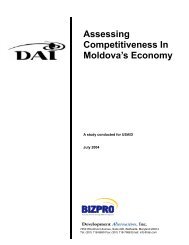the ties that bind - Economic Growth - usaid
the ties that bind - Economic Growth - usaid
the ties that bind - Economic Growth - usaid
Create successful ePaper yourself
Turn your PDF publications into a flip-book with our unique Google optimized e-Paper software.
partnerships with sources to develop organic material grown in conditions <strong>that</strong> conserve<br />
biodiversity.” 1<br />
At <strong>the</strong> June 1992 United Nations Conference on Environment and Development (“Earth<br />
Summit”) in Rio de Janeiro, Chief Bira, Aveda founder Horst Rechelbacher, and<br />
Brazilian anthropologist May Waddington made contact in order to discuss <strong>the</strong><br />
Yawanawa urukum production. In 1993, Mr. Rechelbacher and Ms. Waddington visited<br />
<strong>the</strong> tribe and started a partnership to create an urukum plantation cultivated by <strong>the</strong><br />
Yawanawa to provide Aveda with organic urukum pigment for <strong>the</strong> production of<br />
cosmetics. Aveda provided a loan to <strong>the</strong> Yawanawa to provide for start-up costs<br />
including 13,000 seedlings to be planted in groves, between houses, along paths, and in<br />
<strong>the</strong> deforested areas of <strong>the</strong> community. 3 The loan, worth $50,000, was negotiated to be<br />
paid back through a reduction in price paid by Aveda for <strong>the</strong> finished product (Aveda<br />
agreed to pay twice <strong>the</strong> local market price, and <strong>the</strong>n negotiated a reduction of 20% in<br />
order to cover <strong>the</strong> cost of <strong>the</strong> loan over time). In addition, Aveda also committed an<br />
investment of US $25,000 per year between 1993 and 1997 in order to build<br />
infrastructure and capacity for a long-term partnership.<br />
Challenge Response Cost 2<br />
Lack of planting and production<br />
capabili<strong>ties</strong> to form partnership<br />
Humid conditions led to<br />
improperly dried seeds and<br />
bacteria in international<br />
shipments<br />
Product was not certified organic<br />
for US market<br />
Local malaria outbreak impeding<br />
worker productivity<br />
Desire for greater community<br />
development<br />
Initial loan to OAEYRG to be<br />
paid back through a reduction in<br />
price paid by Aveda<br />
Invest in solar energy panels<br />
and o<strong>the</strong>r infrastructure<br />
Almost immediately <strong>the</strong> project faced stumbling blocks. The humidity in <strong>the</strong> forest<br />
prevented <strong>the</strong> product from drying properly, which led to Aveda receiving shipment upon<br />
shipment of bacteria-infested uruku. After experiencing quality issues working with <strong>the</strong><br />
Yawanawa directly, Aveda decided to contract a firm in Sao Paolo called Formil/Flora<br />
Brasil to process and standardize <strong>the</strong> product before shipping it to <strong>the</strong> United States.<br />
Adding this extra “local” step in <strong>the</strong> distribution, though of no direct monetary benefit to<br />
Aveda, provided a method to ensure quality prior to shipment. In addition, in <strong>the</strong> mid-<br />
1990s <strong>the</strong>re was a malaria outbreak in <strong>the</strong> region. Aveda responded to <strong>the</strong>se and o<strong>the</strong>r<br />
problems throughout <strong>the</strong> mid-1990s by building a health center, putting in panels for<br />
1 Kerry ten Kate and Sara Laird, The Commercial Use of Biodiversity: Access to Genetic<br />
Resources and Benefit-Sharing, Earthscan Publications, London, 1999.<br />
2 May Waddington and Sara Laird, “The production and marketing of a species in <strong>the</strong> „public<br />
domain‟: <strong>the</strong> Yawanawa and Aveda Corporation Bixa orellana Project, Brazil” in The<br />
Commercial Use of Biodiversity.<br />
3 http://aveda.aveda.com/protect/we/uruku.asp<br />
www.Business<strong>Growth</strong>Initiative.org<br />
15<br />
US $50,000<br />
(re-paid over<br />
time)<br />
US $25,000 per<br />
year (1993-1997)<br />
Install special drying machinery US $15,600<br />
Invest in organic certification<br />
inspection process<br />
Invest in local health center with<br />
malaria screening capacity<br />
Invest in building local school<br />
and regional OAEYRG office<br />
Expand solar energy to<br />
residents<br />
US $5,000<br />
US $37,000<br />
US $25,000 per<br />
year (1993-1997)<br />
US $16,500

















